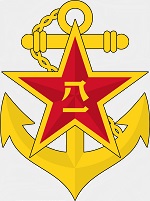Hobby Master HA6409 Chinese Peoples Liberation Army Navy Shenyang J-15 Flying Shark "Flanker-X2" Air Superiority Fighter - "Gray 70", Aircraft Carrier Shandong (CV-17) (1:72 Scale)
"Politics is war without bloodshed, while war is politics with bloodshed."
- Chinese Communist Party Chairman Mao Tse-Tung
 The Shenyang J-15 (NATO reporting name: Flanker-X2 , also known as Flying Shark), is a 4th generation, twin-jet, all-weather, carrier-based fighter aircraft in development by the Shenyang Aircraft Corporation and the 601 Institute for the Chinese People's Liberation Army Navy's aircraft carriers. It is developed from the J-11B as well as from the studying of a prototype Su-33. An unfinished Su-33 prototype, the T-10K-3, was acquired from Ukraine in 2001 and is said to have been studied extensively, reversed engineered, with development on the J-15 beginning immediately afterward. While the J-15 appears to be structurally based on the prototype of Su-33, the indigenous fighter features Chinese technologies as well as avionics from the J-11B program. In February 2018, discussions about a replacements of the aircraft appeared in several Chinese media outlets including Xinhua and China's main military newspaper, contending the shortcomings of the aircraft are obvious since it still belongs to the 4th or 4.5 generation fighters, thus China urgently needs a 5th generation successor to it, one that will be based on J-20, J-31, or a new design.
The Shenyang J-15 (NATO reporting name: Flanker-X2 , also known as Flying Shark), is a 4th generation, twin-jet, all-weather, carrier-based fighter aircraft in development by the Shenyang Aircraft Corporation and the 601 Institute for the Chinese People's Liberation Army Navy's aircraft carriers. It is developed from the J-11B as well as from the studying of a prototype Su-33. An unfinished Su-33 prototype, the T-10K-3, was acquired from Ukraine in 2001 and is said to have been studied extensively, reversed engineered, with development on the J-15 beginning immediately afterward. While the J-15 appears to be structurally based on the prototype of Su-33, the indigenous fighter features Chinese technologies as well as avionics from the J-11B program. In February 2018, discussions about a replacements of the aircraft appeared in several Chinese media outlets including Xinhua and China's main military newspaper, contending the shortcomings of the aircraft are obvious since it still belongs to the 4th or 4.5 generation fighters, thus China urgently needs a 5th generation successor to it, one that will be based on J-20, J-31, or a new design.
China has sought to purchase Su-33s from Russia on several occasions - an unsuccessful offer was made as late as March 2009, but negotiations collapsed in 2006 after it was discovered that China had developed a modified version of the Sukhoi Su-27SK designated the Shenyang J-11B, in violation of intellectual property agreements. However, according to Chinese sources, the reason why China withdrew from talks is because Russia wants big money to re-open Su-33 production lines and insisted China must buy at least 50 Su-33s which China is reluctant and believes it would become outdated in a few years, the same reason why China decided to modify it instead of continuing to assemble the licensed Su-27, or J-11, its name in China.
Pictured here is a 1:72 scale replica of a PLAAN Shenyang J-15 Flying Shark "Flanker-X2" air superiority fighter then emarked upon the Aircraft Carrier Shandong (CV-17).
Sold Out!
Dimensions:
Wingspan: 8-inches
Length: 12-3/4-inches
Release Date: December 2023
 Historical Account: "From Russia with Love" - The Liaoning was initially laid down as the Riga at Shipyard 444 (now Mykolaiv South) in Mykolaiv, Ukraine, on December 6th, 1985. Design work was undertaken by the Nevskoye Planning and Design Bureau. Launched on December 4th, 1988, the carrier was renamed Varyag in late 1990, after the famous cruiser. Often referred to as an aircraft carrier, the vessel's design implied a mission different from carriers of the United States Navy, Royal Navy or French Navy. The Russian term used by her builders to describe the ships is a "heavy aircraft-carrying cruiser", intended to support strategic missile-carrying submarines, surface ships, and maritime missile-carrying aircraft of the Russian fleet. The Soviet Union and later Russia argued that the ships are not aircraft carriers under the Montreux Convention and not subject to the tonnage limits imposed on these ships in traveling through the Bosphorus.
Historical Account: "From Russia with Love" - The Liaoning was initially laid down as the Riga at Shipyard 444 (now Mykolaiv South) in Mykolaiv, Ukraine, on December 6th, 1985. Design work was undertaken by the Nevskoye Planning and Design Bureau. Launched on December 4th, 1988, the carrier was renamed Varyag in late 1990, after the famous cruiser. Often referred to as an aircraft carrier, the vessel's design implied a mission different from carriers of the United States Navy, Royal Navy or French Navy. The Russian term used by her builders to describe the ships is a "heavy aircraft-carrying cruiser", intended to support strategic missile-carrying submarines, surface ships, and maritime missile-carrying aircraft of the Russian fleet. The Soviet Union and later Russia argued that the ships are not aircraft carriers under the Montreux Convention and not subject to the tonnage limits imposed on these ships in traveling through the Bosphorus.
Construction ceased by 1992, with the ship structurally complete but without electronics. With the dissolution of the Soviet Union, ownership was transferred to Ukraine; the ship was laid up, unmaintained. Ukraine immediately began searching for possible customers, and made overtures to China, which sent a high-level expert delegation in 1992. Although the delegation made a positive report on the condition of the ship, recommending a purchase, the Beijing leadership declined because of the international diplomatic situation at the time. Nevertheless, the People's Liberation Army Navy did not lose interest, and four years later took an independent initiative for a commercial purchase.


